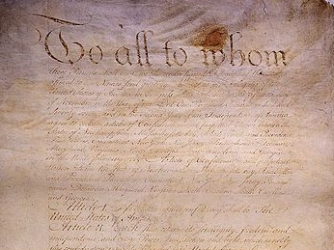On this day in 1781, the Articles of Confederation, the first American constitution, became the official law of the land. It didn’t last a decade, however, for several reasons.
The Second Continental Congress approved the document on November 15, 1777, after a year of debates. The British capture of Philadelphia helped to force the issue. The Articles formed a war-time confederation of states, with an extremely limited central government. The document made official some of the procedures used by Congress to conduct business, but many of the delegates realized the Articles had limitations.
Two days later, Congress submitted the Articles to the states for immediate consideration. However, it took until March 1, 1781, for this “immediate” consideration to become final.
Here is a quick list of the problems that occurred, and how these issues led to our current Constitution.
1. The states didn’t act immediately. It took until February 1779 for 12 states to approve the document. Maryland was the last state to sign the Articles on March 1, 1781, after it settled a land argument with Virginia.
2. The central government was designed to be weak and decentralized. The Articles established that “the United States of America” was a perpetual union formed to defend the states as a group, but it provided few central powers beyond that—it didn’t include an executive official or judicial branch.
3. The Articles Congress only had one chamber and each state had only one vote. This reinforced the power of the states to operate independently from the central government, even when that wasn’t in the nation’s best interest. The states also retained sovereign rights held under their colonial charters.
4. Congress needed 9 of 13 states to pass any laws. Requiring this high supermajority made it very difficult to pass any legislation that would affect all 13 states.
5. The document was also practically impossible to amend. The Articles required unanimous consent to any amendment, so all 13 states would need to agree on a change. Given the rivalries between the states, that rule made the Articles impossible to adapt after the war ended with Britain in 1783.
6. The central government couldn’t collect taxes to fund its operations. The Confederation relied on the voluntary efforts of the states to send tax money to the central government. Lacking funds, the central government couldn’t maintain an effective military or back its own paper currency.
7. While the Articles technically barred states from entering into any “conference, agreement, alliance, or treaty” with a foreign government, states were nevertheless able to conduct their own foreign policies. Technically, that role fell to the central government, but the Confederation government didn’t have the physical ability to enforce that power since it lacked domestic and international powers and standing.
8. States had their own money systems. There wasn’t a common currency in the Confederation era. The central government and the states each had separate money, which made trade between the states and with other countries extremely difficult.
9. The Confederation government couldn’t help settle Revolutionary War-era debts, due to its lack of power to tax. The central government and the states owed huge debts to European countries and investors. Without the power to tax, and with no power to make trade between the states and other countries viable, the United States was in an economic mess by 1787.
10. Shays’ rebellion—the final straw. A protest by western Massachusetts farmers in 1786 and 1787 showed the central government couldn’t put down an internal rebellion. It had to rely on a state militia sponsored by private Boston business people. With no money, the central government couldn’t act to protect the “perpetual union.”
Also, concerns about trade and the need for a uniform economic system alarmed Founders like George Washington, James Madison and Alexander Hamilton to the point where delegates from five states met at Annapolis, Maryland in September 1786 to discuss changing the Articles of Confederation.
The group included Madison, Hamilton, and John Dickinson, and it recommended that a meeting of all 13 states be held the following May in Philadelphia. The Confederation Congress agreed and the Constitutional Convention of 1787 started the process that ended the era of the Articles of Confederation.








